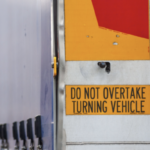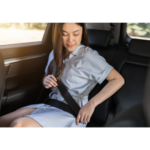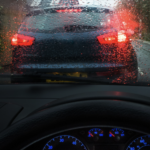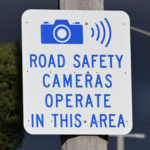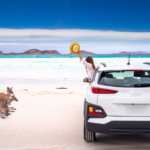Which Driver Has To Give Way on NSW Roads? Know The Rules!
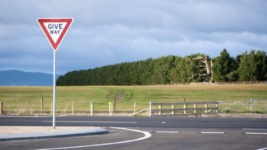
It’s a frequent topic of debate, and a not infrequent cause of road rage incidents: who has to give way to whom on NSW roads?
Luckily, the Road Rules 2014 (NSW) cover almost every give way situation you can think of.
Here’s your ultimate guide to giving way on New South Wales roads.
Give way at a stop sign or stop line
Let’s start off easy, if your vehicle is approaching a stop sign or stop line, you must stop and give way to all traffic before entering the intersection or crossing.
Stopping, means stopping as near as practicable to, but before reaching, the stop line, or, if there is no stop line, the intersection.
Failure to stop at a stop sign or a stop line will amount to either a traffic offence under regulation 67 (for intersections) or regulation 68 (for all other crossings) of the Rules, which comes with a penalty notice of $387 and 3 demerit points at the time of writing, or a maximum fine of $2,200 if the driver elects (chooses) to take the matter to court.
Give way at a give way sign
This one is also self-explanatory, if your vehicle is approaching a give way sign or line , you must give way to all traffic before entering the intersection or crossing.
Who a driver must give way depends on the type of intersection, crossing or roadway being entered into. Generally, a driver must give way to any vehicle in, entering or approaching the intersection, except:
- an oncoming vehicle turning right at the intersection if a stop sign, stop line, give way sign or give way line applies to the driver of the oncoming vehicle; or
- a vehicle turning left at the intersection using a slip lane, or
- a vehicle making a U-turn.
If a driver is turning left using a slip lane, the driver must give way to:
- any vehicle on the road the driver is entering, or turning right at the intersection into the road the driver is entering (except a vehicle making a U-turn at the intersection); and
- any other vehicle or pedestrian on the slip lane.
If the driver is turning left or right or making a U-turn, the driver must also give way to any pedestrian at or near the intersection who is crossing the road, or part of the road, the driver is entering.
Failure to give way at a give way sign will amount to either a traffic offence under regulation 69 (for intersection), or regulation 71 (all other places) of the Rules, which comes with a penalty notice of $387 and 3 demerit points at the time of writing, or a maximum fine of $2,200 if the driver elects (chooses) to take the matter to court.
More complicated rules apply to bridges or narrow roads which have give way signs. Regulation 70 states that a driver approaching a bridge or length of narrow road with a give way sign must give way to any oncoming vehicle that is on, or approaching, the bridge or length of road when the driver reaches the sign.
Driving contrary to this rule comes with a penalty notice of $387 and 3 demerit points at the time of writing, or a maximum fine of $2,200 if the driver elects (chooses) to take the matter to court.
Giving way at a roundabout
Another easy one, regulation 114 of the Rules states that when entering the roundabout a driver must give way to:
- any vehicle in the roundabout, and
- a tram that is entering or approaching the roundabout.
Driving contrary to this rule comes with a penalty notice of $387 and 3 demerit points at the time of writing, or a maximum fine of $2,200 if the driver elects (chooses) to take the matter to court.
You can read more about the rules regarding roundabouts here.
Giving way at an intersection with no signs
The rules get more complicated when at an intersection which does not have any signage.
Regulation 72 outlines the general rules for giving way at an intersection (other than a T-intersection or roundabout), which are:
- If the driver is going straight ahead: the driver must give way to any vehicle approaching from the right, unless a stop sign, stop line, give way sign or give way line applies to the driver of the approaching vehicle.
- If the driver is turning left (except if the driver is using a slip lane): the driver must give way to: any vehicle approaching from the right, unless a stop sign, stop line, give way sign or give way line applies to the driver of the approaching vehicle, and any pedestrian at or near the intersection who is crossing the road the driver is entering.
- If the driver is turning left using a slip lane: the driver must give way to any vehicle approaching from the right or turning right at the intersection into the road the driver is entering (except a vehicle making a U-turn at the intersection), and any pedestrian on the slip lane.
- If the driver is turning right: the driver must give way to any vehicle approaching from the right, unless a stop sign, stop line, give way sign or give way line applies to the driver of the approaching vehicle, and any oncoming vehicle that is going straight ahead or turning left at the intersection (unless a stop sign, stop line, give way sign or give way line applies to the driver of the oncoming vehicle, or the oncoming vehicle is turning left using a slip lane), and any pedestrian at or near the intersection who is crossing the road the driver is entering.
Driving contrary to this rule comes with a penalty notice of $387 and 3 demerit points at the time of writing, or a maximum fine of $2,200 if the driver elects (chooses) to take the matter to court.
Regulation 73 outlines the general rules for giving way at a T-intersection, which are:
- If the driver is turning left (except if the driver is using a slip lane) or right from the terminating road into the continuing road: the driver must give way to any vehicle travelling on the continuing road (except a vehicle making a U-turn on the continuing road at the T-intersection), and any pedestrian who is crossing the continuing road at or near the intersection.
- If the driver is turning left from the terminating road into the continuing road using a slip lane: the driver must give way to any vehicle travelling on the continuing road (except a vehicle making a U-turn on the continuing road at the T-intersection), and any pedestrian on the slip lane.
- If the driver is turning left (except if the driver is using a slip lane) from the continuing road into the terminating road: the driver must give way to any pedestrian who is crossing the terminating road at or near the intersection.
- If the driver is turning from the continuing road into the terminating road using a slip lane: the driver must give way to- any vehicle approaching from the right (except a vehicle making a U-turn from the terminating road at the T-intersection), and any pedestrian on the slip lane.
- If the driver is turning right from the continuing road into the terminating road: the driver must give way to any oncoming vehicle that is travelling through the intersection on the continuing road or turning left at the intersection, and any pedestrian who is crossing the terminating road at or near the intersection.
Driving contrary to this rule comes with a penalty notice of $387 and 3 demerit points at the time of writing, or a maximum fine of $2,200 if the driver elects (chooses) to take the matter to court.
Giving way when entering a road
If you’re entering a road from a driveway, parking lot, nature strip or other road-related area and no signage is present, you have a comprehensive set of obligations to give way.
Regulation 75 of the Rules notes that a driver entering a road related area or adjacent land from a place on a road without traffic lights or signage must give way to:
- any pedestrian on the road, and
- any vehicle or pedestrian on any road related area that the driver crosses or enters, and
- if the driver is turning right from the road–any oncoming vehicle on the road that is going straight ahead or turning left, and
- if the road the driver is leaving ends at a T-intersection opposite the road related area or adjacent land and the driver is crossing the continuing road–any vehicle on the continuing road.
Driving contrary to this rule comes with a penalty notice of $387 and 3 demerit points at the time of writing, or a maximum fine of $2,200 if the driver elects (chooses) to take the matter to court.
Giving way to particular vehicles
Certain vehicles have privileged right of way in NSW, it’s important to know when you must defer to these vehicles on the road.
Under regulation 77 of the Rules, a person driving on a length of road in a built-up area, in the left lane or left line of traffic, must give way to a bus in front of the driver if:
- the bus has stopped, or is moving slowly, at the far left side of the road, on a shoulder of the road, or in a bus-stop bay, and
- the bus displays a give way to buses sign and the right direction indicator lights of the bus are operating, and
- the bus is about to enter or proceed in the lane or line of traffic in which the driver is driving.
Driving contrary to this rule comes with a penalty notice of $387 and 3 demerit points at the time of writing, or a maximum fine of $2,200 if the driver elects (chooses) to take the matter to court.
Under regulation 79 of the Rules, a driver must give way to a police or emergency vehicle that is displaying a flashing blue or red light (whether or not it is also displaying other lights) or sounding an alarm.
Driving contrary to this rule comes with a penalty notice of $514 and 3 demerit points at the time of writing, or a maximum fine of $2,200 if the driver elects (chooses) to take the matter to court.
Defending against a give way offence
It is important to be aware that the onus rests on the prosecution to prove any failure to give way allegation beyond a reasonable doubt.
That being so, those who believe that were on the right side of the law can apply for a review or, if this is refused, elect (choose) to take the matter to court and put the prosecution to proof; in other words, make them prove the allegations.
Arguments put forth in court when defending such allegations include:
- The offence did not occur as alleged, or at all,
- Someone else was driving the car when the violation occurred (misidentification),
- The penalty notice is invalid, due to an error in or insufficiency of material particulars, and/or
- An emergency justified the violation or the conduct occurred as a result of being threatened with imminent serious harm.
It is important to carefully consider whether to elect to take a penalty notice to court, as it can result in a harsher penalty than that which comes with the penalty notice.
That said, a court also has discretion to deal with the matter by way of a non-conviction order such as a section 10 dismissal in the event you wish to plead guilty or are found guilty and seek leniency.
Getting a non-conviction order means there is no fine or demerit points.
Going to court over a traffic offence?
If you are you going to court to contest a traffic offence, call Sydney Criminal Lawyers anytime on 9261 8881 to arrange a free first conference during which one of our experienced traffic lawyers will assess the case, advise you of your options and the best way forward, and fight for the optimal outcome.

